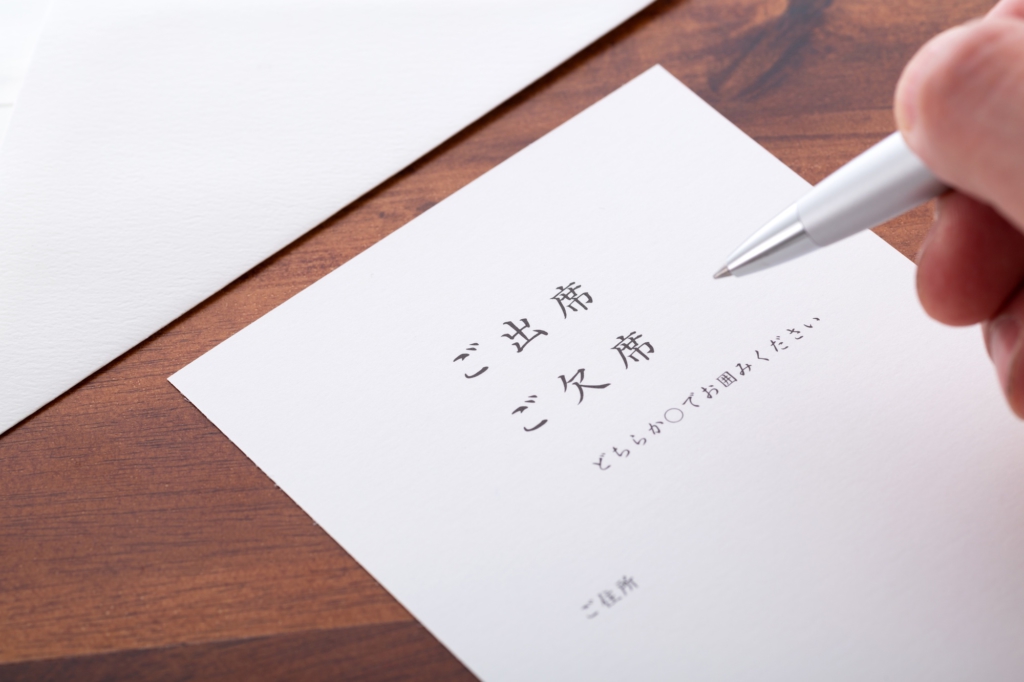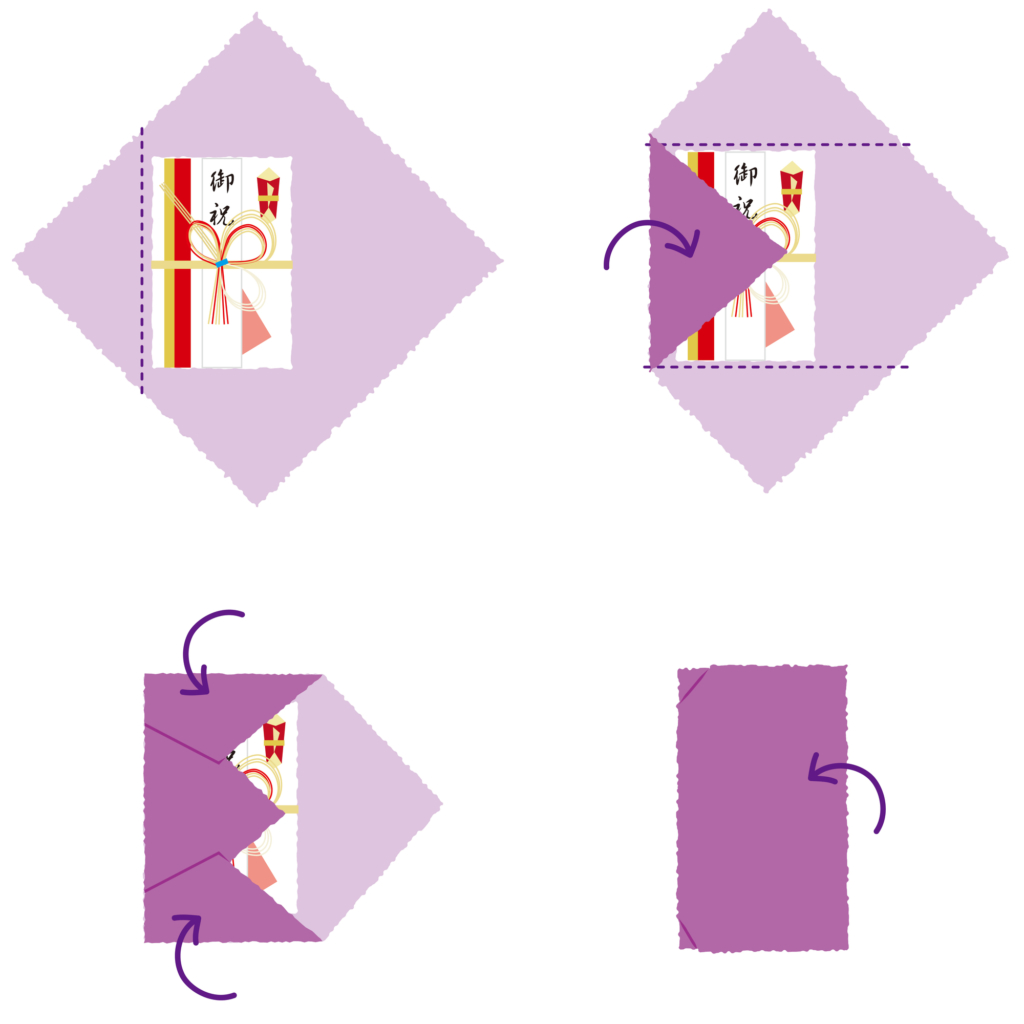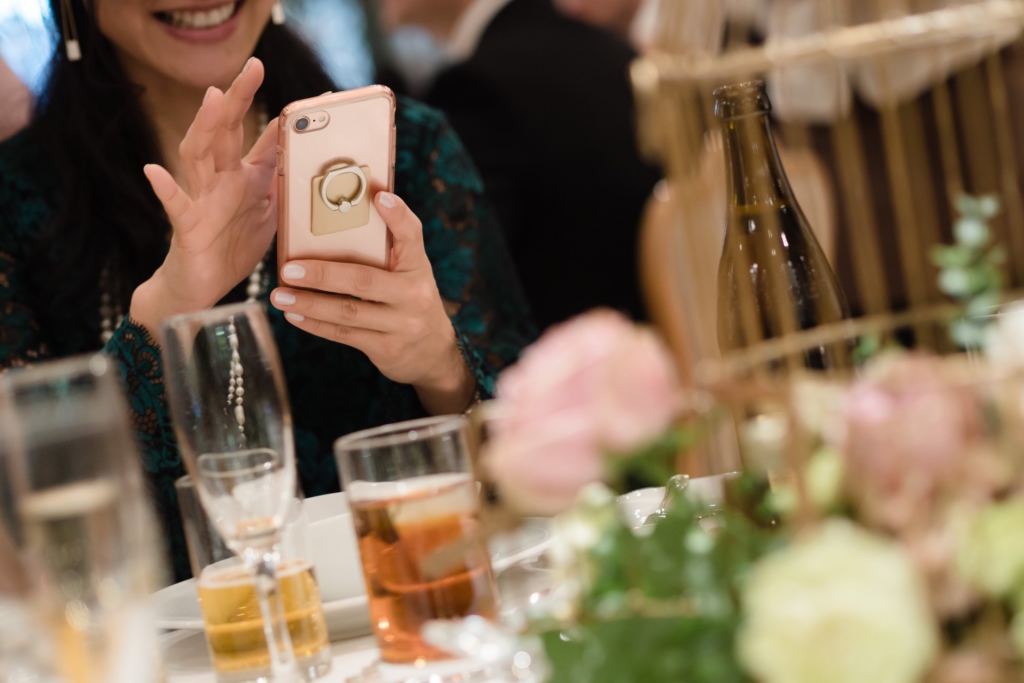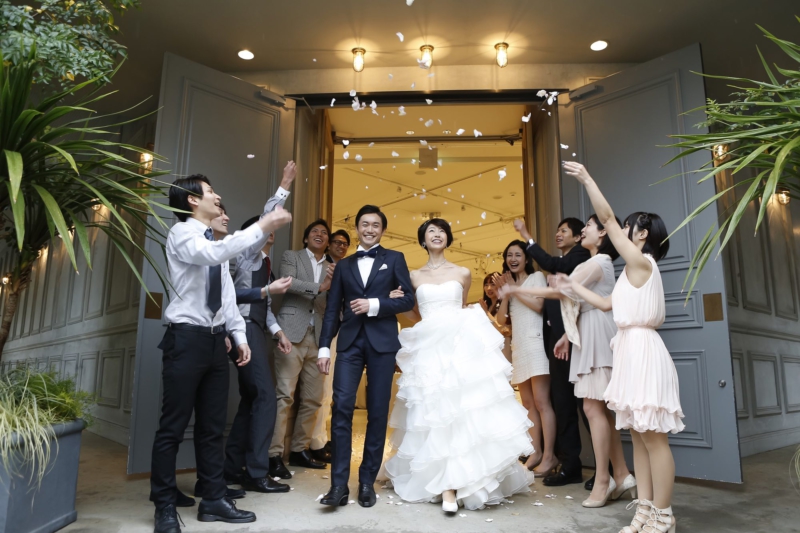There is so much to do when you are invited to a wedding. Replying to the invitation, preparing things to bring, deciding what to wear and how to style your hair, and so on. There are also certain customs that you should be aware of if you are invited to a wedding in Japan, including complicated rules on “goshugi” (the gift of money given to the bride and groom) and expected conduct on the day of. This article will introduce you to these customs and etiquette rules. Make sure to familiarize yourself with them in advance so that you can fully enjoy the wedding on the day.
1. RSVP as Soon as Possible

It is no exaggeration to say that a wedding starts when you respond to the invitation. With wedding preparations, there are many things that cannot proceed unless you know who’s coming, such as seating, meal arrangements, and deciding on the number of gifts to prepare. Therefore, you should aim to RSVP within 2 to 3 days of receiving the invitation, or before the deadline at the very latest. If, for any reason, you cannot confirm your availability until a later date, even if that is before the deadline, it is polite to let them know your circumstances. Once you receive a wedding invitation, consider yourself to be an important part of the wedding and make an effort to reduce the burden for the couple.
There is also an etiquette to the way you respond to invitations. Although a lot of weddings today have become less formal, oftentimes they will still follow conventional rules. For example, when writing your response, you should double-strikethrough the honorific prefix “go” (御 or ご). This is because the “go” is added to words such as “present” (御出席/ご出席) or “absent” (御欠席/ご欠席) to convey politeness and respect to the guests. On the response, however, it’s improper to refer to your own presence/absence with this respectful tone, hence the strikethrough. It is also an unspoken rule to add a message to the couple if there is some space left on the invitation.
A recent trend is to reply by adding a drawing or some artwork to the invitation. Although this could be perceived as too casual or rude if the reply was to your boss or someone older than you, if the invitation was from a close friend, it could be a wonderful way to express your feelings.
2. Dietary Requirements Should Be Communicated in Advance

One of the pleasures of attending a wedding reception is the food and drink. If the wedding is held at a hotel, most of the time, the menu will be a set course menu. Therefore, it is polite to let the host know in advance if you have any food allergies or dietary requirements. Recently, a lot of wedding invitations include a section where you can write your dietary requirements. It should be noted that this only applies to those with allergies, so you should avoid writing your food preferences. If you are vegetarian, vegan, or follow any other type of diet, you can try writing that in, but just in keep in mind that it may be difficult to accommodate if the wedding food is a set course menu. It also doesn’t help that most Japanese people are not vegetarian or vegan. The dietary requirement section is also applicable for those who cannot eat certain foods due to religious reasons.
If the invitation doesn’t have a dedicated space for dietary restrictions, write it somewhere else, or get in touch with the couple directly and make sure your needs are communicated.
3. Don’t Forget! Things to Bring to a Wedding

A wedding is a once-in-a-lifetime experience for the bride and groom. Guests should therefore also make sure they are fully prepared so that they can be present and celebrate. To avoid any surprises, it’s important to make sure that you have everything you need at the wedding. Here are some essentials that you should prepare:
1. Money to give as a gift (“goshugi”) and appropriate envelope (“goshugi bukuro”)
2. Silk wrapping cloth or “fukusa” (used to wrap your goshugi; you could alternatively use a handkerchief)
3. Invitation (just in case, as most invitations will have important information such as how to get to the venue)
4. Handkerchief
5. Cell phone/smartphone
6. Camera
7. Wallet
8. A spare pair of stockings (for women—in case they end up ripping, it’s good to have another pair)
After the wedding, it’s common to receive a gift from the couple, known as “hikidemono.” Therefore, it is best to keep your belongings to a minimum. You often see men show up to weddings with a small bag or carrying nothing at all. If traveling from afar, rest assured; most big wedding venues will have a reception area where they can keep large bags or suitcases. If the wedding is in the winter, most of the time you will be able to leave your coats and scarves at the reception as well, so they won’t be in the way during the ceremony. This way, you can dress as warm as you need on your way to the venue.
4. Decoding Goshugi Culture! How Much to Give? What to Write? How to Present it on the Day?

The Amount of Money to Give as Goshugi
At Japanese weddings, it is the custom for guests to congratulate the couple by giving them money, known as goshugi. The amount given is usually around 30,000 JPY. This amount should not be an even number (such as 20,000 JPY or 40,000 JPY), because even numbers can be easily divided, which is considered poor symbolism for a marriage. An exception to this rule is the number 8, which is a lucky number in Japan. The shape of the Chinese character (八) is wider at the bottom, conveying good luck. Note that the numbers 4 and 9 are considered bad luck, so they should also be avoided. 4 in Japanese is sometimes pronounced “shi,” the same as “death” (死); similarly, 9 is sometimes pronounced “ku,” the same as “agony” (苦).
The goshugi is a gift to the bride and groom for starting a new chapter of their lives together as a couple. It is a courtesy for guests to use new bills (obtained from the bank) to show that you’ve put time and effort into the gift. Don’t forget to prepare these in advance.
If the wedding and reception are held on separate days, a goshugi is often just given on one of the two days.
Choosing and Writing on the Goshugi Bukuro

When choosing a goshugi bukuro, make sure you pay attention to the knots known as “mizuhiki.” There are two different types of “mizuhiki” used for enclosing the goshugi – the “musubikiri” (on top) or the “awaji-musubi” (in the middle). Both of these knots cannot be undone, which symbolizes the fact that marriage happens only once. On the other hand, “cho-musubi” (on the bottom) is a type of knot that can be re-done many times. This makes the “cho-musubi” inappropriate for weddings, but appropriate for other types of celebrations that you would wish to happen many times.
Nowadays, you can find a great variety of goshugi bukuro. The mizuhiki can come in various colors and can be tied using different numbers of strings. The envelope itself can also come in a variety of colors or be made using different materials. These stylish goshugi bukuro could give a slightly casual impression, so try to think about who you are giving the money to first. Friends, colleagues, or other people who you are close with should find no problem receiving them. Note that entirely gray goshugi bukuro with black-and-white or yellow knots are for funerals. Make sure you don’t choose them by mistake.
On the envelope you will write your name, the amount of money enclosed, and your address. You should not use a ballpoint pen; you must use a brush pen or a bold black pen. Thin black ink is normally used for funerals, so the etiquette is to use thick black ink. On the front of the envelope, you will write the “occasion” and your name. The “occasion” is usually either 寿 (kotobuki = congratulations), 御祝 (oiwai = celebration), or 御結婚御祝 (gokekkon oiwai = celebrating your marriage). If you are attending the wedding reception, you would normally write 寿 (kotobuki). Nowadays, you can use envelopes that already have the occasion printed on them, which can be found in general stores.
There are different ways to fold the goshugi bukuro, and each type of fold has a different meaning. For celebratory occasions, including weddings, the bottom fold on the backside of the outer envelope should go over the top. This signifies the hope that happiness will be stored up and not lost. On the contrary, if the upper part of the envelope is folded over the bottom, this signifies the hope that sadness will flow away. This way of folding the envelope is used for funerals and is not appropriate for weddings.
Inside the goshugi bukuro is another envelope to enclose the money. Place the bills inside the envelope so that the portrait on the bill faces the front. As the bride and groom will be receiving many goshugi, make sure you write the amount of money you are giving, your name and your address on the inner envelope. On the front of the envelope, write “金 ○○円,” using Chinese characters to represent numbers (and the formal ones as well, i.e. one=壱, two=弐, three=参). On the back, write your address and name. All writing on the goshugi bukuro should be done vertically.
How to Present the Goshugi
Goshugi are basically handed over at the reception table on the day of the wedding. A special silk cloth called a “fukusa” is used to wrap the goshugi bukuro so that it doesn’t get dirty or bent. There are various types of fukusa. Usually for celebratory occasions like weddings, a warm color is appropriate. Black or gray is for funerals, so make sure you don’t pick these colors. Alternatively, purple is appropriate for any occasion. Look at the illustrations below to see how you wrap the goshugi bukuro.

If you cannot attend the wedding or if you haven’t been invited, you could still give some money to the couple as a gift. However, make sure you give it to them at least a week in advance of the wedding. If you cannot give it to them by hand, you could post it by registered mail for sending cash, known as “genkin kakitome”. Even if you are sending the money by mail, use a goshugi bukuro, as this is a special occasion. Note that it is not appropriate to send the money to the venue on the day of the wedding. Make sure you address it to the bride and groom’s home or their parents’ address.
When Goshugi Are Not Necessary
Recently, there are weddings that require a set attendance fee from guests, which cover various costs such as food. Most weddings in Hokkaido are done in this style, where attendance fees are requested from guests. In these cases, there is no need to give goshugi. There are also instances where the couple requests guests not to bring goshugi. This can be stated on the invitation, and if this is the case, no goshugi will be necessary.
5. Appropriate Outfits and Hairstyles for Weddings: Elegant But Not Too Flashy!

Weddings are special occasions, and it is the etiquette to make sure you look your best. You must remember, though, that you should not outshine the bride or groom. Outfits that are too flashy or revealing (such as short skirts) are not appropriate. You should also wear your hair nicely in a way that is well suited for the occasion. For women, wearing your hair down can be considered too casual. If possible, it is best to put your hair up.
Men should choose a black or dark-colored suit to complement the groom. Ties should not be black, as they are associated with funerals. Business suits are also not the best, as they lack formality. However, if you are going to wear a business suit, accessorize for a more elegant look. For both women and men, wearing a white dress or suit is not appropriate, as you can look too similar to the bride or groom. It is also not appropriate to wear any animal print, leather items, or fur, as they symbolize killing or death.
If you are thinking of wearing a Japanese outfit to the wedding, here are the guidelines. For women who are colleagues or friends of the bride or groom (regardless of your marital status), it is recommended you wear a “homongi.” For single women, you also have the choice of wearing a “furisode.” However, if the bride will be wearing a “hon-furisode” (sleeve length of approximately 114 cm), it is best for you to wear a “naka-furisode” (sleeve length of approximately 100 cm), which is a lower rank.
For men, a plain-colored “iromontsuki” that is not black but either navy, gray, or brown is appropriate. Avoid designs with noisy patterns. You can avoid drawing attention away from the bride and groom by wearing a plain-colored kimono and “haori” (a short coat you wear on top of the kimono) or ones that have simple designs. The haori is considered the same as a jacket in formal occasions, so make sure to wear one. Japanese outfits have their own set of rules, so it’s best to check with the kimono store or rental shop on how to wear it to a wedding.
Today, there are many unique weddings that are held in various venues, from hotels to restaurants. Outfits and hairstyles should suit the time of the ceremony, the venue, and the specific occasion. Make sure you meet the basic etiquette rules, but also consider the atmosphere of the wedding, venue, and guests so that your outfit and hairstyle will suit the occasion.
6. Things to Keep in Mind on the Day

On the day of the wedding, don’t forget to actively participate in making the wedding a joyful occasion. Firstly, make sure you arrive at the venue 20 to 30 minutes in advance so that you don’t have to rush. When you see people at the wedding, congratulate them by saying “omedeto gozaimasu.” This includes not just to the bride and groom, but also people at the reception table and relatives of the couple. Speeches and performances will take place during the reception. When they begin, stop eating and face the stage so that you pay full attention. Only go to the restroom in between performances, while you are having your meal, or while the bride is changing outfits.
It’s good to liven up the atmosphere, but it’s best not to be too casual, as relatives of the bride and groom will also be present at the wedding. If there is an after-party planned, that may be the place to be a bit more casual, as oftentimes relatives will not attend.
7. When Is the Best Timing for Presenting a Wedding Gift?

If you are attending the wedding and giving goshugi, then in most cases you do not need to prepare a separate gift. If you would like to give a gift in addition to the goshugi, it is possible to hand this over at the reception table, should the item be small. However, it is probably best to send it separately to the couple so that you don’t have to carry it on the day. Before the wedding can be a busy time for the bride and groom. If you are sending a gift, you should send it so that they receive it once things have settled down, probably about a week after the wedding.
8. What If You Are Asked to Perform at the Wedding? Things Not to Do

During a wedding reception, there may be speeches by bosses or performances by friends. If you are asked by the bride or groom to perform, make sure you make it appropriate and prepare in advance. You wouldn’t want to ruin such a special occasion for the bride and groom!
You should also be aware that the running order for weddings are usually down to the minute. If you are given some time to do a speech or performance, make sure you don’t go over the time. Always keep in mind that this is a special occasion attended by lots of guests, including families and relatives. It is important to make sure that your speech or performance isn’t inappropriate or full of inside jokes. If you are planning to use any technological equipment at the venue, such as a projector, you must rehearse. Technical difficulties happen very often at weddings, and could be difficult to resolve. Check with the staff to make sure that your video will display appropriately and the sound is adequate.
9. Don’t Go Overboard at the After-Party! Etiquette Rules You Should Know

At most weddings, an after-party usually follows the wedding reception. Contrary to the reception that is attended by relatives and has a more formal feel, the after-party usually gathers close friends. They are attended by those who participated in the wedding reception, but some people will attend just the after-party. Usually these parties have a fee to attend, so a goshugi will not be necessary. The fee does not have to be paid using new bills either. As this is a party where the bride and groom can enjoy themselves with close friends, it is acceptable to participate in a more casual outfit. It is best to choose your outfit taking into account the atmosphere of the venue. As with the reception, white clothes or clothes that are too revealing should be avoided.
Although the after-party can be similar to a “nomikai,” you should remember that the purpose is to congratulate the bride and groom. Make sure you don’t get too carried away.
10. What to Do if You Are Running Late or Have to Cancel

If you cannot attend the wedding due to a scheduling conflict, let the bride and groom know as soon as possible. Respond accordingly to the invitation if you haven’t yet done so. On the other hand, if you have already responded to the invitation, it is best to speak to them on the phone and apologize, rather than emailing or texting. Once the number of guests is confirmed, meal and gift preparations will already be underway. Therefore, oftentimes with last-minute cancellations, you will still need to give the same goshugi amount as those who attended (around 30,000 JPY).
If, due to an emergency, you have to cancel on the day, the etiquette is to call the venue. The bride and groom are too busy on the day and will not be able to take your call. You could contact a friend who will be attending, but if you want to make sure your message gets across, it’s best to call the staff at the venue. They will know when it is best to speak to the couple. Although you should be honest when you explain your reason for cancelling, if it is because of an unfortunate event such as a death in the family, you should keep it vague at the time. After the wedding, congratulate the newlyweds, apologize, explain why you had to cancel and present the goshugi. If you are cancelling on the day, the goshugi should be the same amount as those who attended (around 30,000 yen), as meals and gifts would have already been prepared.

A wedding is a very special occasion for the bride and groom and their families. As such, it is important for guests to follow basic etiquette rules. Make sure you read this article and fully understand these rules so that you are well prepared to celebrate on the day. And even more importantly, take the time to enjoy it!
If you want to give feedback on any of our articles, you have an idea that you’d really like to see come to life, or you just have a question on Japan, hit us up on our Facebook!
The information in this article is accurate at the time of publication.

